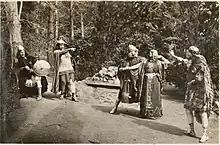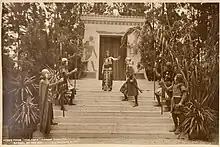Bertha Newberry
Bertha Newberry (May 24, 1874 – January 10, 1934) was an American playwright, poet, and longtime resident of Carmel-by-the-Sea, California. She was the wife of Carmel mayor Perry Newberry. She gained recognition as an actress and for being the author of the Egyptian play titled "The Toad," that was staged in 1912 at the Forest Theater in Carmel. Four of her poems were chosen as part of The Anthology of California Poets in 1932.[1][2]
Bertha Newberry | |
|---|---|
 Bertha Newberry in 1912 | |
| Born | Bertha G. Bair May 24, 1874 |
| Died | January 10, 1934 (aged 59) |
| Occupation(s) | Playwright, poet |
| Known for | Poems |
| Notable work | "The Toad" |
| Spouse | Perry Newberry (1892–1934) |
Early life
Bertha Newberry was born on May 24, 1874, in Coldwater, Michigan. Her parents were Isaac C. Blair (1837-1899) and Ida Weeks (b. 1852) both from Coldwater. She married Perry Newberry on October 18, 1892, in Coldwater. He called her "the best girl in town."[1][3][4] Her nickname, "Buttsky," arose from the rumor that she would supposedly save partially smoked cigarette butts to enjoy later.[2]
Career
.jpg.webp)
The Newberrys moved to Chicago, where her husband became partner in an insurance agency. In 1997, they moved to San Francisco by train for a job in the art department at the San Francisco Examiner.[4] They moved into a rundown artist's studio on the fourth floor of the Montgomery Block Building, familiarly referred to as "the Monkey Block." The rent was $6 a month, with no running water, no bath, and shared lavatories at the end of the hall. Bertha wrote poetry, while Perry pursued his career as a reporter and editor for various newspapers, including the San Francisco Examiner, and the San Francisco Post. It was during this time that Perry heard about an art colony in Carmel-by-the-Sea, California, through conversations at Frank Coppa's restaurant, a popular spot among San Francisco's Bohemians.[3][1] In November 1905, Sunset Magazine of San Francisco, published an early poem by Bertha Newberry.[5]
In 1910, the couple arrived in Carmel-by-the-Sea, making the journey by stagecoach. Enamored by the charm of the place, they purchased two lots on Carmel Point from Frank Devendorf and Frank Powers, and soon after, they embarked on building their own house on Carmelo Street.[3][4][1] The Newberrys were part of the cultural circle that included Jack London, Harry Leon Wilson, James Hopper, Mary Hunter Austin, Arnold Genthe, Francis McComas, Xavier Martinez, and Sinclair Lewis.[6]
In 1912, Bertha's poetry The Beloved, was selected to be part of Mitchell Kennerley's The Lyric Year One Hundred Poems. This recognition was shared honor with writer George Sterling, as they represented California in this anthology.[1][7][8]
In 1922, her husband was elected to the Carmel board of trustees and became the fifth mayor of Carmel. Bertha joined him in numerous spirited battles against the progressive faction, standing by his side as they fought for their shared beliefs and values. Newberry was known for his efforts to "keep Carmel free from tourists," and Keep Carmel off the Map."[9][10][3]
On February 2, 1922, The Caramel Pine Cone published the poem The World by Bertha Newberry.[11] In 1933, four of her poems were included in the Anthology of California Poets, published by the House of Henry Harrison of New York.[1][2][12]
Forest Theater

David
The Newberrys were founding members of the Forest Theater Society of Carmel.[13] Her husband became actor, producer, playwright, and president at the Forest Theater. On July 9, 1910, Herbert Heron produced the first of the annual theatrical productions at the Forest Theater. The play David, was a biblical drama by Constance Skinner under the direction of Garnet Holme of UC Berkeley.
Bertha had the role Sarah in the play; Helen MacGowan Cooke took on the role of Michal; Heron was in the title role as David and writer Alice MacGowan as Astar. The play was reviewed in both Los Angeles and San Francisco, and was reported as "a big success."[14][10]
The Toad

The Toad, an ancient Egyptian three-act production, written by Bertha Newberry and produced by Garnet Holme, played at the Forest Theater from July 3 and 4 1912. Perry Newberry played the leading role as Toad, the king's Dwarf; John T. Gribner as Ahmes, the King's scheming brother; Joseph W. Hand played Tinro, the inspector of the walls; artist Mary DeNeale Morgan played Arbela; Daisy Fox Desmond played an Egyptian dancer; Helen Cooke as Cleis, Seeress of Amon; and artist Xavier Martínez as the third assassin, among others.[15][16] The San Francisco Examiner praised the production, declaring that "It bloomed to-night in the full flower of success."[17]
In 1912, the Forest Theater Society faced a disagreement concerning the selection of a play to produce. Despite Herbert Heron's Montezuma being a contender, it was not chosen; instead, The Toad was the favored option. However, Heron contended that The Toad bore a striking resemblance to a play he had penned, and George Sterling supported his claim. In the midst of this controversy, Perry Newberry stood firmly by his wife's side, and their faction emerged victorious, resulting in The Toad being the chosen production for the theater society.[2][3]
Subsequently, Bertha received an invitation to repeat the performance of The Toad with a cast consisting of Carmel residents, at the University of California, Berkeley at the Greek Theater on July 20. Following the success of their show, they were hosted by Frank Powers at his fraternity house, where they were honored and entertained.[3][18] On August 14, 1914, The Toad was produced in the open-air River Theater on the San Lorenzo River in Santa Cruz, California.[19][2]
Jason and the Argonauts
Jason and the Argonauts, written by Bertha Newberry for the Pageant of the Seven Seas, was held on November 18-20, 1913, at the Dreamland Pavilion for the Seamen's Institute. Grace MacGowan Cooke contributed to the Columbus at the Court of Ferdinand and Isabella episode, and author Guy Moyston for the Magellan Rounding Horn episode.[20]
A Thousand Years Ago
The play A Thousand Years Ago, written by Percy MacKaye and produced by Perry Newberry, was performed on July 3 and 4, 1917. Bertha played the character of a Chinese Woman of the Court. Joseph W. Hand played one of the Lords of the Royal Divan; Ernest Schweninger played Calaf, Prince of Astrakhan; and Katharine Cooke played Turandot, Pricess of Pekin.[16][1][21]
Androcles and the Lion
In July 27-28 1917, Bertha Newberry acted as a Christian Martyr in the play Androcles and the Lion, by George Bernard Shaw, with her husband producing it at the Forest Theater. The play, put on as a Carmel Arts and Crafts Summer Play, included the characters Joseph Hand as Julius Caesar, Katharine Cooke as Lavinia, Ernest Schweninger as the captain and others.[16][21]
Perry Newberry Cottage
The Perry Newberry Cottage, or "Sticks and Stones" is an American Craftsman-style one-story house that was built in 1937 by builder Maynard McEntire. It is located on the northern side of Vista Avenue, the second house to the west of Junipero Avenue.[22][23][24]
The Newberry house was registered, by Kent L. Seavey, with the California Register of Historical Resources on May 20, 2002. It qualifies as a historical house under the California register criterion 2, as the last residence designed by Perry Newberry, and significant under criterion 3, as a unaltered example of a vernacular cottage designed with Craftsman style features.[25]
Death
Bertha Newberry suffered from health problems from an early age. On January 10, 1934, she passed away at the Monterey Hospital following a long illness, at the age of 59. Private funeral services were held by Rev. Austin Chinn, of the Carmel All Saints Church, at Paul's Mortuary in Pacific Grove. Burial was at the Monterey City Cemetery.[13][1][2]
References
- "Bertha Newberry Passes After Lingering Illness". Carmel Pine Cone. Carmel-by-the-Sea, California. January 12, 1934. p. 1. Retrieved July 14, 2023.
- Dramov, Alissandra (2012). Carmel-by-the-Sea, The Early Years (1803-1913). pp. 42–43. ISBN 9781491824146. Retrieved March 3, 2023.
{{cite book}}:|work=ignored (help)CS1 maint: location missing publisher (link) - Wright, Connie (2014). "Bertha "Buttsky" Newberry". Stories of old Carmel: A Centennial Tribute From The Carmel Residents Association. pp. 34–35. OCLC 940565140.
{{cite book}}:|work=ignored (help)CS1 maint: location missing publisher (link) - "His checkered career path led from tinker and soldier to Journalist" (PDF). Carmel Pine Cone. Carmel-by-the-Sea, California. December 27, 2019. p. 30. Retrieved April 21, 2022.
- "Good Reading". The Ventura Weekly Post and Democrat. Ventura, California. November 10, 1905. Retrieved July 15, 2023.
- "Interview with James Hopper". Harrison Memorial Library. Carmel-by-the-Sea, California. 1952. Retrieved March 16, 2022.
- "George Sterling Captures Prize". Oakland Tribune. Oakland, California. December 6, 1912. Retrieved July 15, 2022.
- Earle, Ferdinand (1912). The Lyric Year One Hundred Poems. Retrieved July 15, 2022.
{{cite book}}:|work=ignored (help)CS1 maint: location missing publisher (link) - "Perry Newberry, Writer And Former Carmel Mayor, Dies". Salinas Morning Post. Salinas, California. December 7, 1938. p. 2. Retrieved March 16, 2022.
- Hudson, Monica (2006). Carmel-by-the-sea. p. 64. ISBN 9780738531229. Retrieved March 16, 2022.
{{cite book}}:|work=ignored (help)CS1 maint: location missing publisher (link) - "The World by Bertha Newberry". Carmel Pine Cone. Carmel-by-the-Sea, California. February 2, 1922. p. 8. Retrieved July 14, 2023.
- Harrison, Henry (1932). California poets, An anthology of 244 contemporaries. Retrieved July 15, 2023.
{{cite book}}:|work=ignored (help)CS1 maint: location missing publisher (link) - "Funeral Services For Writer Today". Salinas Morning Post. Salinas, California. January 13, 1934. p. 3. Retrieved July 15, 2023.
- "Poet Walks With Plumber In Play". he San Francisco Call. San Francisco, California. July 10, 1910. p. 39. Retrieved March 15, 2022.
- "Wild Animals I Have Met, vol. 1". Harrison Memorial Library. Carmel-by-the-Sea, California. 916. Retrieved August 5, 2022.
- "Forest Theater Plays". Harrison Memorial Library. Carmel-by-the-Sea, California. July 9, 1910. Retrieved March 15, 2022.
- "Forest Theatre Flows in Mystic Beauty, Carmel's Big Night Thrills Aesthetes". The San Francisco Examiner. San Francisco, California. July 5, 1912. Retrieved July 15, 2023.
- "'The Toad' Is Given Classic Greek Setting". The San Francisco Call. San Francisco, California. July 21, 1912. Retrieved July 15, 2023.
- ""The Toad" Makes Hit; To Be Repeated Tonight". Santa Cruz Evening News. Santa Cruz, California. August 15, 1914. Retrieved July 15, 2023.
- "Five Authors Write Pageant of the Seven Seas". The San Francisco Examiner. San Francisco, California. October 19, 1913. Retrieved July 15, 2023.
- "Arts and Crafts Club Scrapbook". Harrison Memorial Library. Carmel-by-the-Sea, California. 1917. Retrieved June 22, 2022.
- "Carmel Inventory Of Historic Resources Database" (PDF). City Of Carmel-by-the-Sea. Carmel-by-the-Sea, California. Retrieved February 15, 2023.
- "Homes of Famous Carmelites" (PDF). ci.carmel.ca.us. Carmel-by-the-Sea, California. 1992. Retrieved April 11, 2023.
- Dramov, Alissandra; Momboisse, Lynn A. (2016). Historic Homes And Inns Of Carmel-by-the-Sea. Carmel-by-the-Sea, California: Arcadia Publishing. p. 26. ISBN 9781467103039. Retrieved April 2, 2023.
- Richard N. Janick (July 31, 2002). "Department Of Parks And Recreation" (PDF). National Park Service. Retrieved June 21, 2022.
External links
- "Bertha B. Newberry (1874 - 1934) - Historical Marker". Find a Grave. www.findagrave.com. Retrieved July 15, 2023.